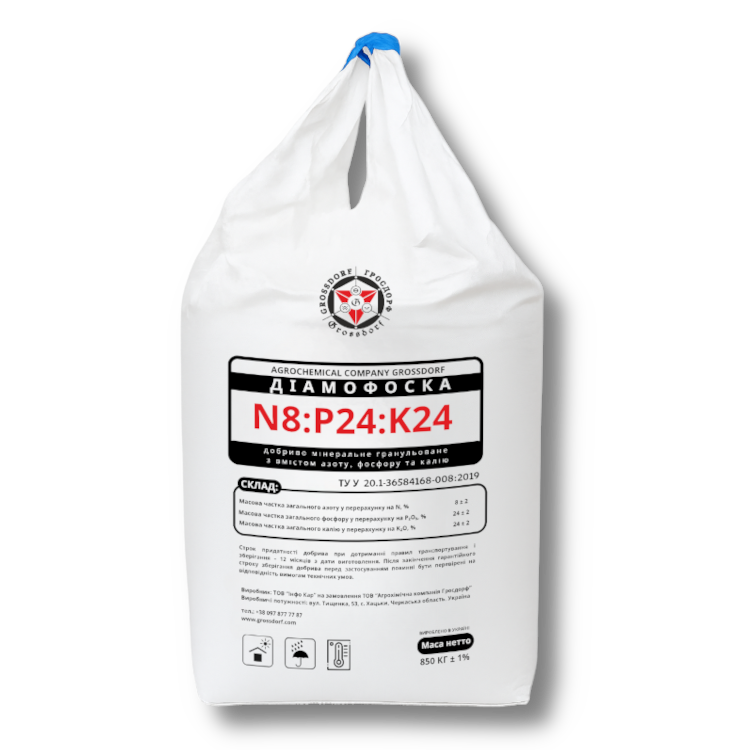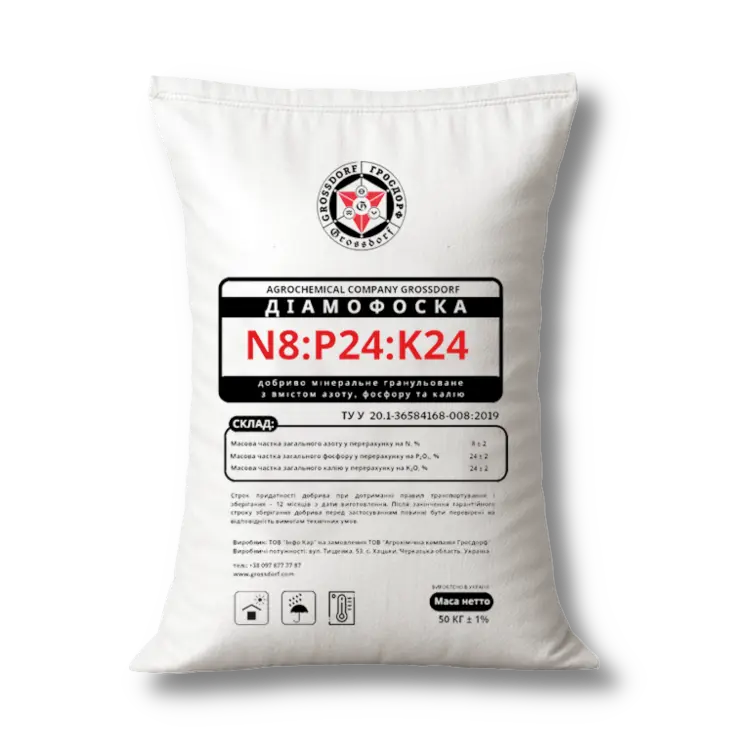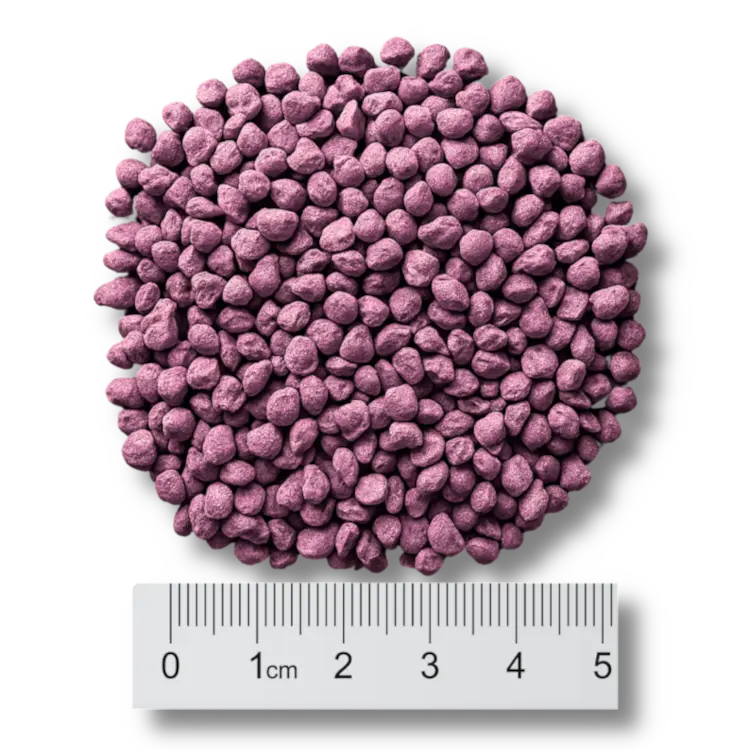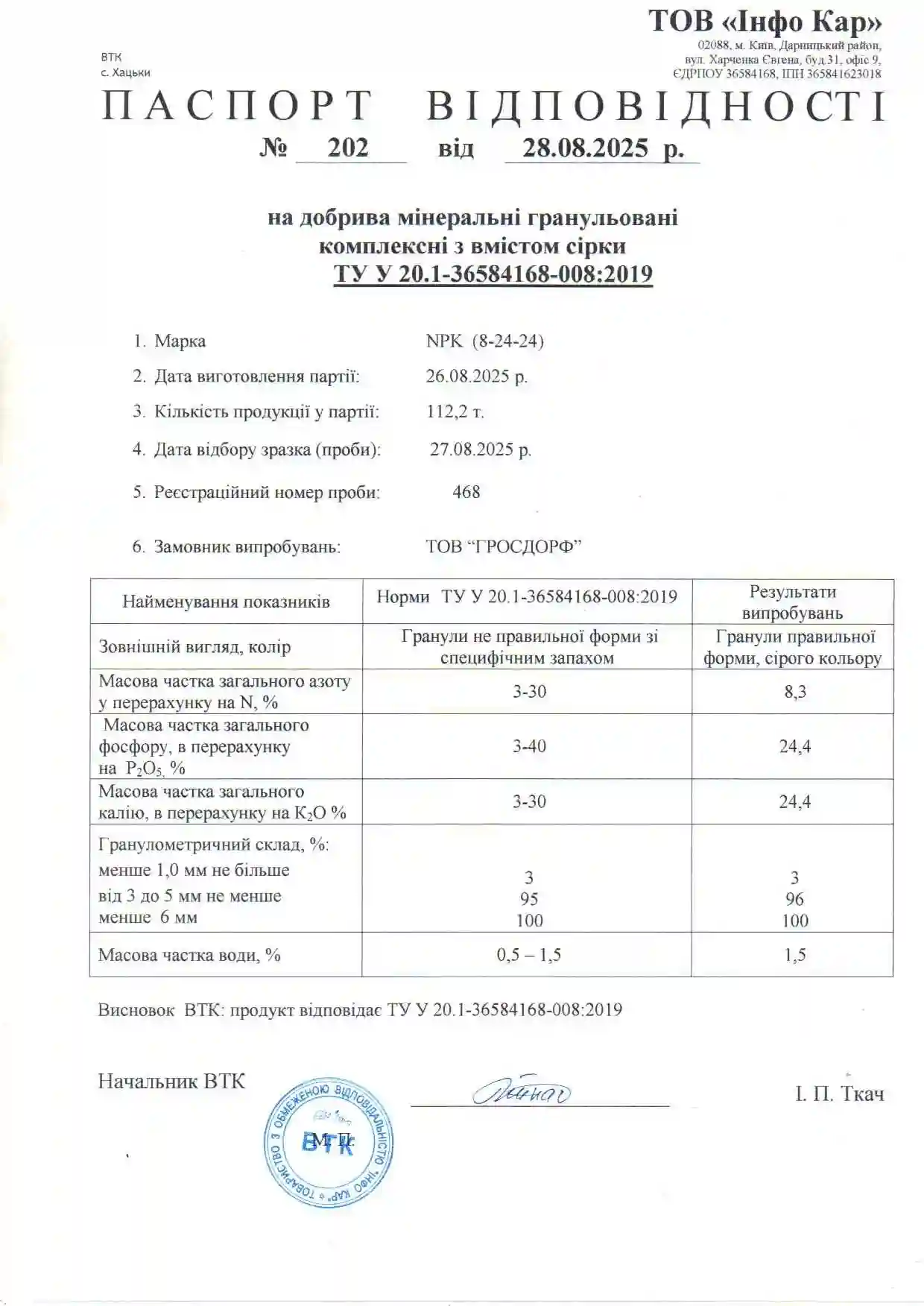Diammonium phosphate N8:P24:K24
Granular mineral fertilizer containing nitrogen,
phosphorus, and potassium — “NPK 8:24:24”
TU U 20.1-36584168-008:2019
Sales/packing terms: EXW, FCA, big bag, 50 kg bag
Delivery terms: own transport across Ukraine or self-pickup
Khatsky, Cherkasy region | Mayaky, Vinnytsia region | Poltava | Ternopil |
|---|---|---|---|
34 500 | 34 500 | 34 500 | 34 500 |
Diammonium Phosphate N8:P24:K24 is a granular mineral fertilizer containing nitrogen, phosphorus, and potassium, formulated to nourish a wide range of crops with high phosphorus and potassium demands, especially during the yield formation stage.
Advantages:
- Nitrogen (8%) in ammonium form (NH₄⁺) – not leached from soil, enhances phosphorus uptake;
- Phosphorus (24%) – fully water-soluble, rapidly reaches the root zone, improves rooting, flowering, and reproductive development;
- Potassium (24%) – enhances dry matter accumulation, drought and disease resistance, and improves crop quality;
Recommended use
For basic or pre-sowing application under: winter and spring cereals (wheat, barley, rye, oats), corn, sunflower, rapeseed, legumes (peas, soybeans, chickpeas), sugar beet, potato, vegetables, orchards and vineyardsAppearance and сolor: irregularly shaped granules with a characteristic odor
| Mass fraction of total nitrogen in terms of N, % | 8 ± 2 |
| Mass fraction of total phosphorus in terms of P₂O₅, % | 24 ± 2 |
| Mass fraction of total potassium in terms of K₂O, % | 24 ± 2 |
| Granulometric composition, % | |
| Less than 1 mm no more | 3 |
| 3 to 5 mm not less than | 95 |
| less than 6 mm | 100 |
- Store in dry, well-ventilated areas, protected from direct sunlight; maintain relative humidity below 70%; keep on pallets at least 15 cm above the ground, in a single layer.
- Packaging (bags, big bags) must be sealed to prevent moisture ingress.
- Acceptable storage temperature: –20°C to +35°C (avoid high humidity; if caking or condensation occurs, loosen before use).
- Avoid contact with acids, alkalis, organic compounds, or other fertilizers that may trigger chemical reactions.
- For long-term storage, periodically loosen the product.
Shelf life: 12 months from the date of manufacture if transportation and storage conditions are met. After the warranty period expires, the product must be tested for compliance with the technical specifications before use.
| Culture | Application period /rate, kg/are | Special application conditions | |||
|---|---|---|---|---|---|
| Pre-sowing cultivation | First fertilization | Second fertilization | Third fertilization | ||
| Cereal сrops | |||||
| Winter wheat | 1,1-1,5 | - | - | - | applied in autumn before plowing or deep digging |
| 0,6-1,0 | - | - | - | at sowing, into the rows | |
| Maize | 3,0-4,0 | - | - | - | applied in autumn before plowing or deep digging |
| 3,0-3,8 | - | - | - | into pre-sowing cultivation | |
| 0,17-0,3 | - | - | - | in rows when sowing | |
| Spring barley | 1,5-2,0 | - | - | - | in autumn during ploughing/digging or before sowing |
| 0,3-0,5 | - | - | - | at sowing, into the rows | |
| Oats | 1,5-3,0 | - | - | - | in autumn under plowing/digging or pre-sowing cultivation |
| 0,3-0,5 | - | - | - | at sowing, into the rows | |
| Industrial crops | |||||
| Sunflower | 3,0 | - | - | - | during primary tillage or before sowing |
| Sugar beet | 3,0 | - | - | - | during primary tillage or before sowing |
| 0,5 | - | - | - | at sowing, into the rows | |
| Oilseeds | |||||
| Winter rape | 3,0 | - | - | - | during autumn (fallow) tillage or before sowing |
| 0,5 | - | - | - | at sowing, into the rows | |
| Soybeans | 2,0 | - | - | - | during primary tillage or before sowing |
| Oil flax | 2,0 | - | - | - | during autumn (fallow) tillage or before sowing |
| 1,0 | - | - | - | at sowing, into the rows | |
| Vegetables | |||||
| Tomatoes | 2,0-2,5 | - | - | - | before plowing or during pre-sowing cultivation, if no further fertilization is planned |
| 1,0-1,3 | - | - | - | when planning fertilization | |
| 0,5 | - | - | - | during seedling transplanting | |
| - | 0,7 | - | - | 10 to 12 days after seedling transplanting | |
| - | - | 0,7 | - | during flowering | |
| Peppers | 2,0-2,5 | - | - | - | before plowing or during pre-sowing cultivation, if no further fertilization is planned |
| 0,8-1,3 | - | - | - | when planning fertilization | |
| Zucchini | 3,0-4,0 | - | - | - | before plowing or during pre-sowing cultivation, if no further fertilization is planned |
| 1,5-2,5 | - | - | - | when planning fertilization | |
| - | 0,7 | - | - | during flowering | |
| - | - | 0,7 | - | at the beginning of fruiting | |
| Cucumber | 1,0-3,0 | - | - | - | before plowing or during pre-sowing cultivation, if no further fertilization is planned |
| до 1,7 | - | - | - | when planning fertilization | |
| - | 0,7 | - | - | formation of 3-4 leaves | |
| - | - | 1,0 | - | complete before vine spreading begins | |
| Aubergine | 1,0-3,0 | - | - | - | under plowing or cultivation (if no other fertilizations are planned) |
| до 1,7 | - | - | - | when planning fertilization | |
| 0,5 | - | - | - | during seedling transplanting | |
| - | 0,7 | - | - | 10–12 days after transplanting | |
| - | - | 0,7 | - | 10–12 days after the first fertilization | |
| Potatoes and other root crops | |||||
| Potatoes | 2,0-4,0 | - | - | - | in autumn under plowing/digging |
| 2,0-3,8 | - | - | - | в into pre-sowing cultivation | |
| 0,3 | - | - | - | at sowing, into the rows | |
| Table beet | 2,0-3,3 | - | - | - | in autumn under plowing or digging, or into pre-sowing cultivation |
| 0,6 | - | - | - | at sowing, into the rows | |
| Carrots | 2,0-3,0 | - | - | - | in autumn under plowing or digging, or into pre-sowing cultivation |
| 0,6 | - | - | - | at sowing, into the rows | |
| Radish | 2,0-3,0 | - | - | - | in autumn under plowing or digging, or into pre-sowing cultivation |
| 0,6 | - | - | - | at sowing, into the rows | |
| Onion | 3,0-4,5 | - | - | - | under plowing or into pre-sowing cultivation, if no other fertilizations are planned) |
| 1,8 | - | - | - | when planning fertilization | |
| 0,7 | - | - | - | at planting | |
| - | 1,0 | - | - | 10–14 days after emergence | |
| - | - | 1,0 | - | at the bulb formation stage | |
| Garlic | 3,0-4,5 | - | - | - | under plowing or into pre-sowing cultivation, if no other fertilizations are planned) |
| 1,3-2,8 | - | - | - | when planning fertilization | |
| 0,75 | - | - | - | at planting | |
| - | - | 1,0 | - | at the beginning of clove formation | |
| Fruit trees and berry trees | |||||
| Apple tree | 4,7 | - | - | - | fertilization in autumn |
| Pear tree | 3,6 | - | - | - | in spring before flowering |
| Cherry tree | 4,7 | - | - | - | fertilization in autumn |
| Raspberry | 4,0 | - | - | - | fertilization in autumn |
| Wild Strawberry/Garden Strawberry | 2,6 | - | - | - | fertilization in autumn |
| Grapes | 0.025 kg per 1 m² | - | - | - | into root zones in spring |
| Blueberry | Fertilization should be carried out twice a year: at the beginning of the growing season (April) and at the end (August–September). After planting: 2nd year – 1 tablespoon, 3rd year – 2 tablespoons, 4th year – 4 tablespoons, 5th year – 8 tablespoons, 6th year and beyond – 16 tablespoons or 40–50 g per mature bush | ||||
| Flowers and lawn grasses | |||||
| Rose | 1,5-2,0 | - | - | - | applied in autumn before plowing or deep digging |
| 0,015-0,020 | - | - | - | into the planting hole | |
| - | 0.010 per 10 liters of water | - | - | after pruning and before the emergence of the first leaf | |
| - | - | 0,010 per 10 liters of water | - | during the period of intensive growth, full bloom, and second flowering | |
| Tulips | 3,0 | - | - | - | one month before planting, during ploughing/digging |
| - | 1,7 | - | - | у in the budding phase, apply to furrows to a depth of 8-10 cm between rows of plants, followed by incorporation into the soil | |
| Lawn grasses | 2,5-3,0 | - | - | - | in autumn before lawn establishment |
| - | 2,2 | - | spring or summer fertilization (June–August) | ||
| Conifers | |||||
| Boxwood | 3,5 | - | - | - | in spring (April-May) 35 g/m2 |
| 1,0 | - | - | - | at planting, into the hole, 10 g/m² | |
| Juniper | 3,0 | - | - | - | in spring (April–May) at 30 g/m² |
| 0,5 | - | - | - | at sowing, into the hole, 5 g/m² | |
| Thuja | 3,0 | - | - | - | in spring (April–May) at 30 g/m² |
| 0,5 | - | - | - | when planting in the hole 0.5 g/m2 | |
Note: It is best to fertilize all fruit and berry plants with complex fertilizers in spring, followed by soil digging. When feeding trees, it is recommended to incorporate the fertilizer into the soil at a depth of 8–10 cm.
The fertilizer application rates were developed by the Department of Agrochemistry and Soil Science of Uman National University of Horticulture under the scientific supervision of Doctor of Agricultural Sciences, Professor Hospodarenko H.M., commissioned by AC Grossdorf. These recommendations are the intellectual property of AC Grossdorf and may be distributed only with proper attribution to the owner.
The provided application rates are generalized and do not replace the need for consultation with an agronomist.




